Another Pachyrhinosaurus is not something I needed in my collection. I already have five of them. But Pachyrhinosaurus is a favorite ceratopsian of mine and none of the figures I own quite nail the look of it for me. Safari’s comes close but it’s a bit too svelte for my tastes, and while Battat’s has the bulk that I desire its paintjob holds it back from true greatness. Thank goodness then for Haolonggood and their 2023 Pachyrhinosaurus, which finally delivers a Pachyrhinosaurus that nails it all on every front.
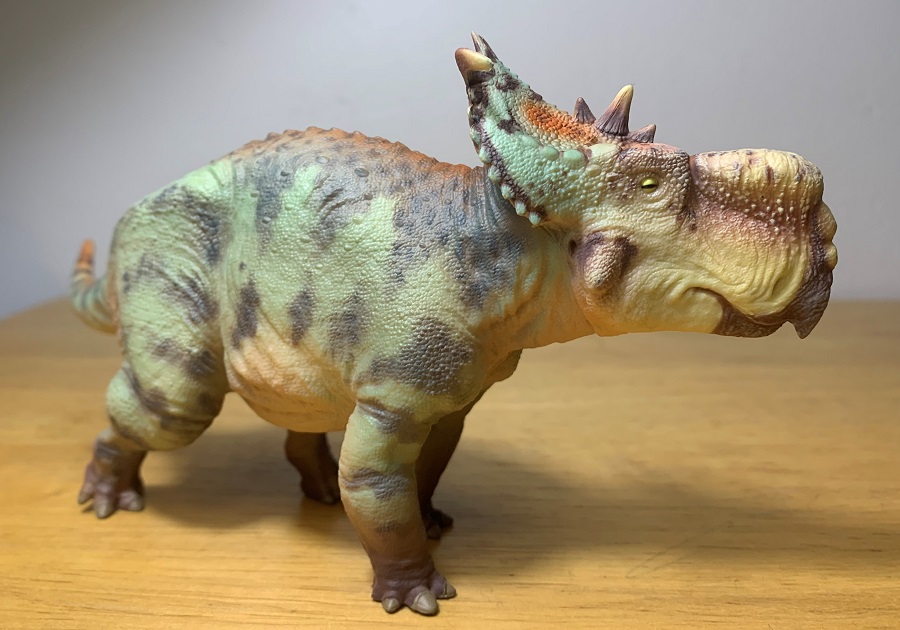

Perhaps the only major criticism one could laud at the Haolonggood Pachyrhinosaurus is that it represents P. lakustai, the same species that every other Pachyrhinosaurus figure represents. There are two other Pachyrhinosaurus species, P. canadensis and P. perotorum. They each have their own unique skull anatomy and come from their own separate formations. So, for example, if you wanted to recreate the Horseshoe Canyon formation you would need P. canadensis, and there isn’t one, so you’re SOL. P. lakustai is known from the Wapiti Formation.

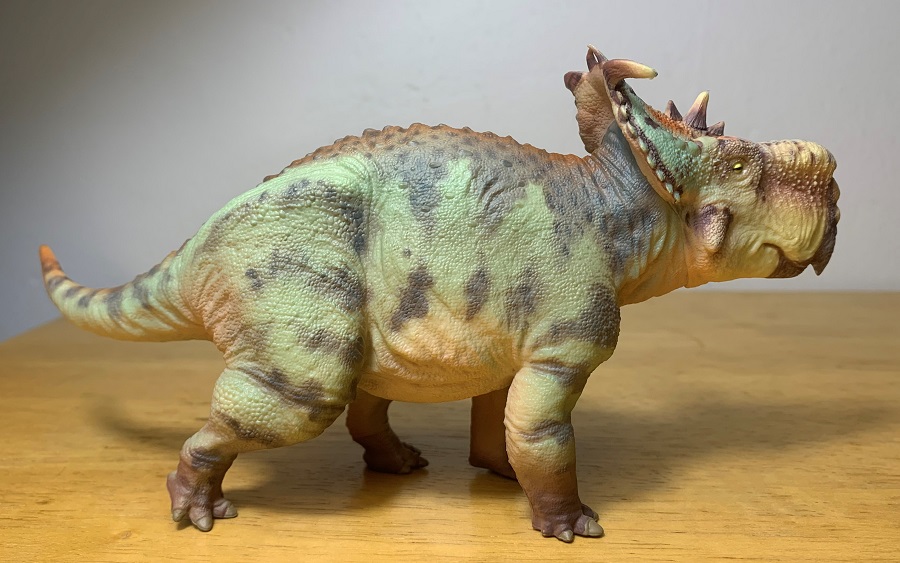
Haolonggood advertises this figure as being 1/35 in scale. It measures about 7” (17.78 cm) long and stands 3.5” (8.89 cm) tall to the top of the frill. P. lakustai is estimated to have measured 16.4’ (5 meters) so the figure actually comes out to be 1/25-1/28 in scale.
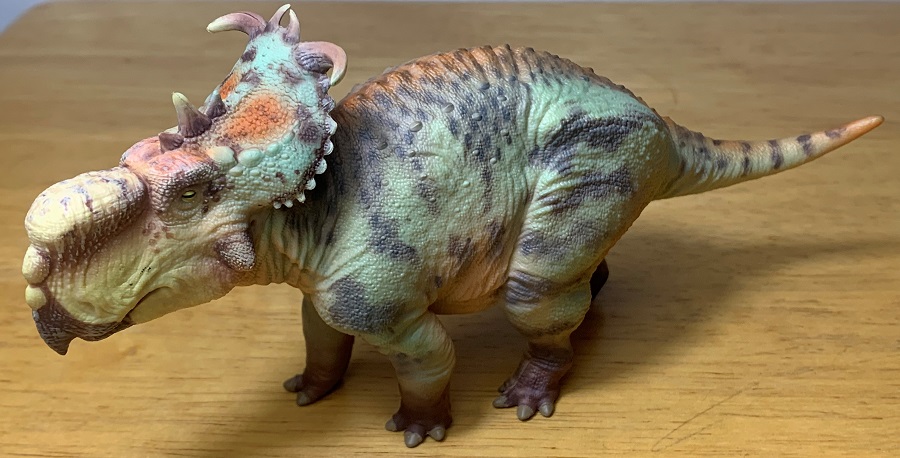
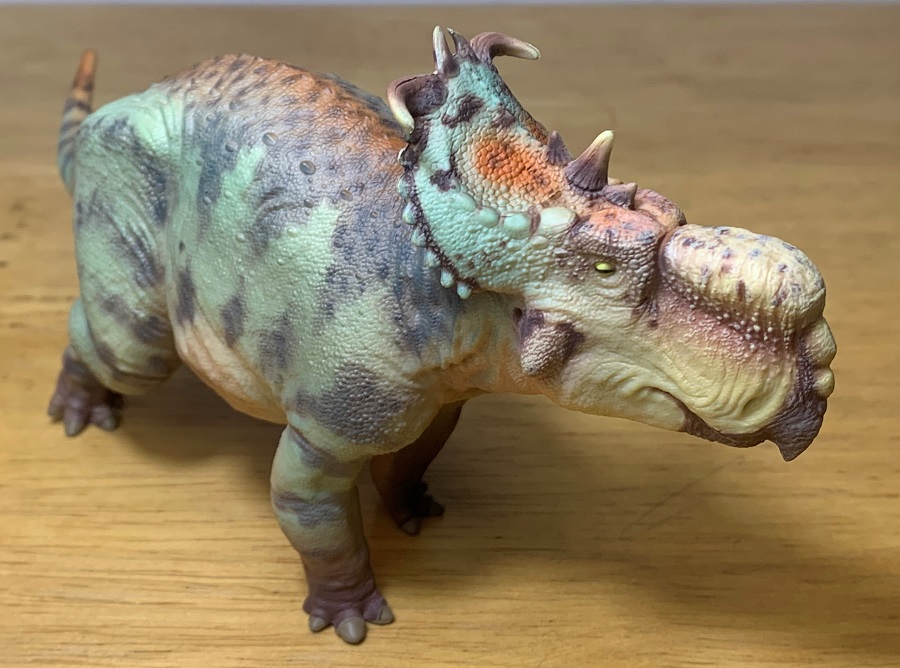
The figure is presented in a static pose with the head lifted high and right hindfoot pushing off the ground with its toes. Overall, the figure has a burly, bulky appearance that I really enjoy. The neck is thick, torso robust, hips wide, calves muscular, and thighs ample. Only the Battat figure comes close to approaching the robustness of this figure. PNSO’s is a sturdy animal too but other features, like the rough skin texture and unique approach to the keratin on the head, put me off to it.


Speaking of a rough skin texture, Haolonggood has quickly refined their figures, as the scalation on this figure is much finer than on their Nasutoceratops, their first ceratopsian that was released only a few months ago. The fine pebbly scales that cover most of the body are appropriately small and interspersed with larger feature scales over much of the body and rows of small scutes along the back. Five digits are sculpted on each forelimb and four on each hindlimb. Digits 4 and 5 on the forelimbs are clawless, as they should be, but are supporting the animal’s weight when they shouldn’t be. A cloaca appears to be sculpted on the underside but it’s hard to discern.
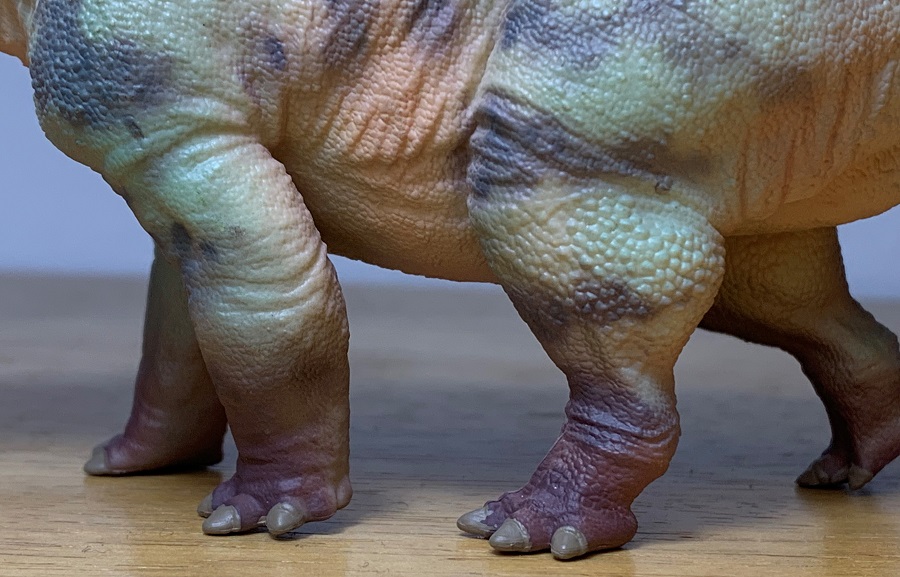
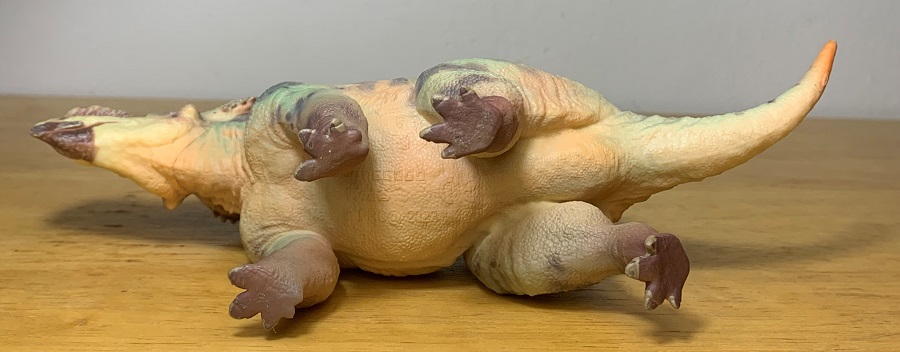
The head sculpt is exceptional and another major selling point for this figure overall. It has a somewhat laterally compressed look when viewed head on or from above but the skull itself is deep. The keratinous beak has a layered texture to it. Where the skin transitions to the nasal boss there’s a nice pebbly texture and stretched skin growing up along the sides, making the boss look like part of the animal instead of a tacked-on afterthought.

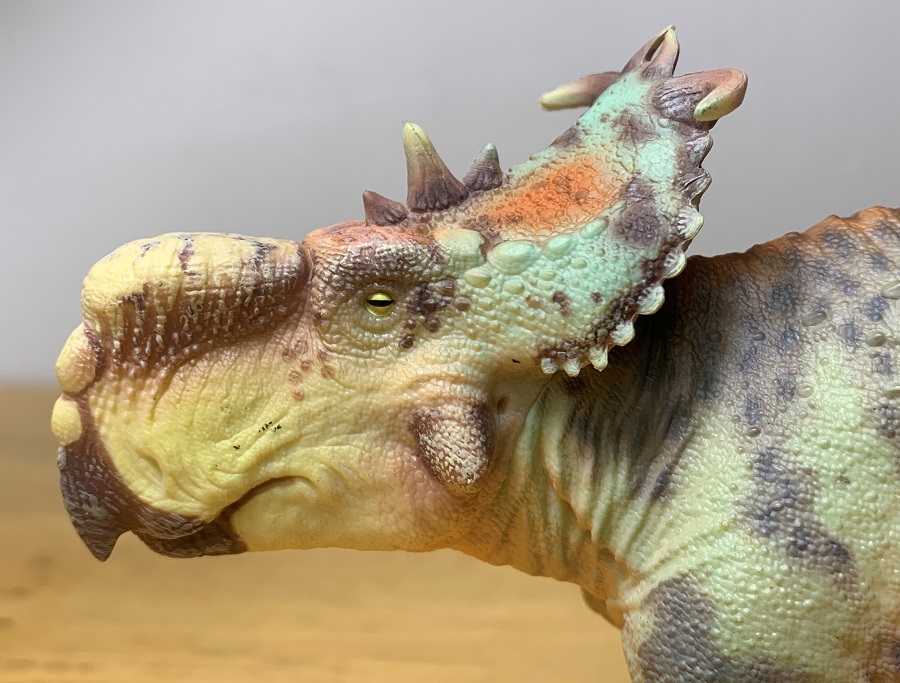
Two supraorbital bosses are sculpted above the eyes and behind those you have the three small horns that make the figure identifiable as P. lakustai, and probably the reason it’s the most popular of the three species. Atop the frill are two horns that hook inwards and two larger horns that hook outwards. Additional scutes, scales, and small horns adorn the head and frill. Nostrils and ear openings are sculpted on the head, but the nostrils are not highlighted at all and easy to overlook. A touch of shading inside the nostrils would have helped make them more obvious. A small horn should be present on the end of each jugal bone but they are not, the bones are just covered in skin and scales.

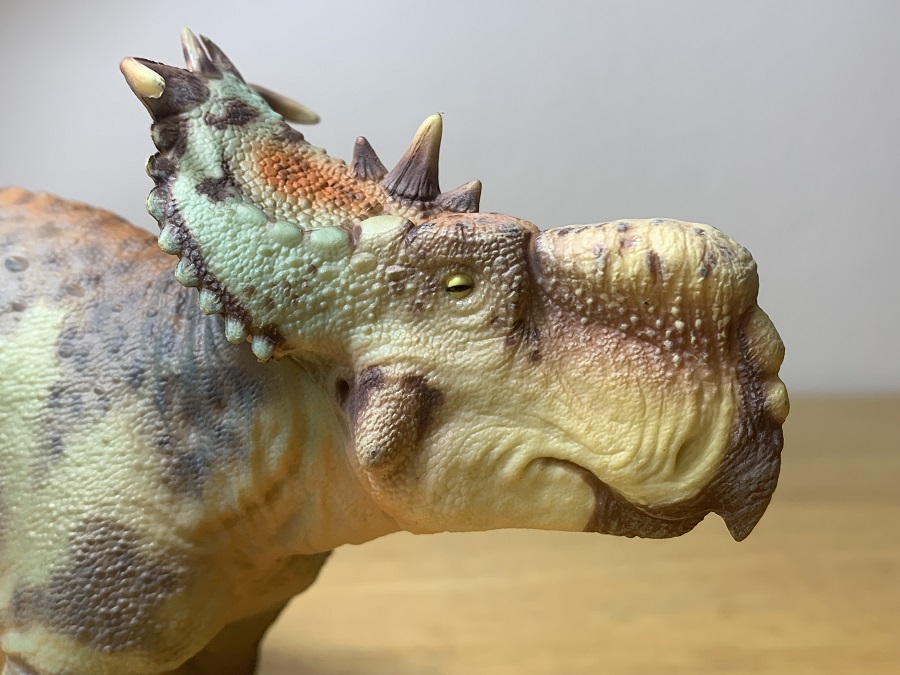
Like all Haolonggood figures this Pachyrhinosaurus comes in two different color schemes. This green one and a brown one. The green variant seems to be the favorite among collectors and it’s my favorite of the two as well. Patterning on both figures is about the same, and even the paintjob on the head is about the same too. The main difference is just the body color. This one is a pale, almost pastel green overall. The face is pale yellow with pink along the edges and bases of the horns and bosses. The beak is brown and there are some brown speckles around the face. The frill is green with brown speckles and splotches. The fenestra and tops of the supraorbital bosses are painted bright orange. The back of the frill is yellow and pink, and it abruptly transitions to green on the neck. I would have preferred some blending of the colors here but it’s not really noticeable unless you’re looking for it.
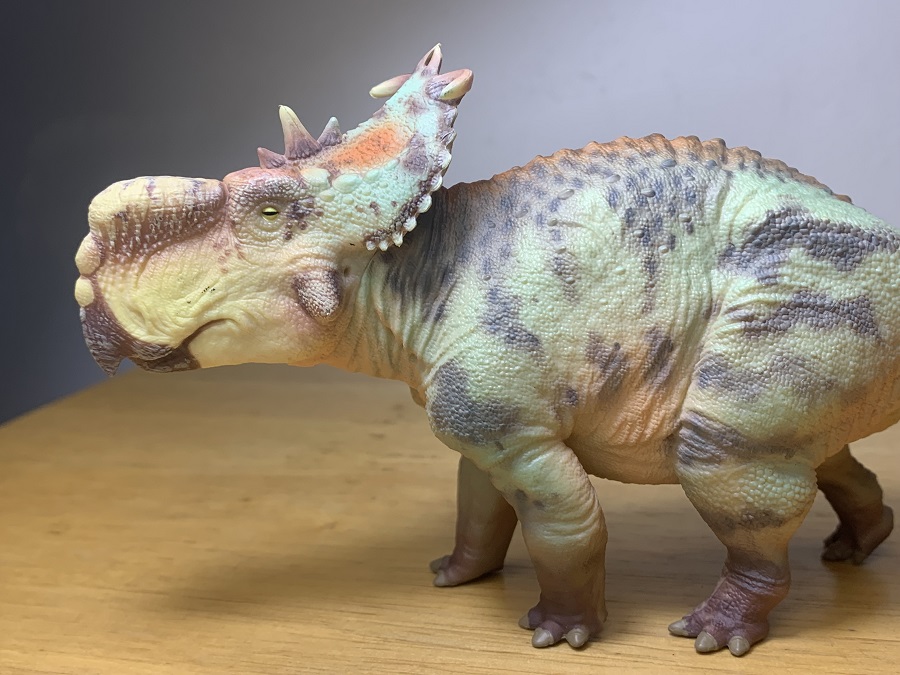

A bright orange stripe runs down along the back to the tip of the tail. The orange fades to brown that bleeds down the flanks. Dark brown tightly clustered spots overlay the brown on the back and additional brown splotches, speckles, and bands decorate the rest of the body. The underside is pale orange, and the hands and feet are a dark brownish pink. The claws are gray. This is an extraordinarily complex paintjob, and my description doesn’t really do it justice.

Of particular note are the eyes, which are yellow with black horizontal pupils. Many extant herbivorous animals, like goats, have horizontal pupils like this. In grazing animals, horizontal pupils allow for a panoramic view of their surroundings. It’s not something normally attributed to dinosaurs, but the Pachyrhinosaurus in Prehistoric Planet had them. Some people dislike this design choice, but I think it’s unique.
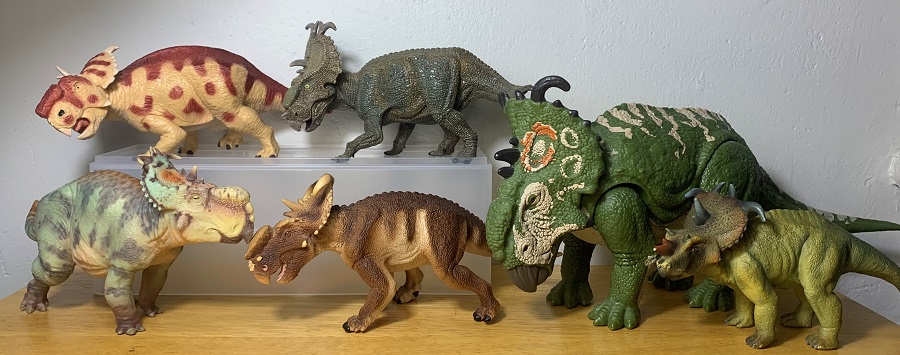
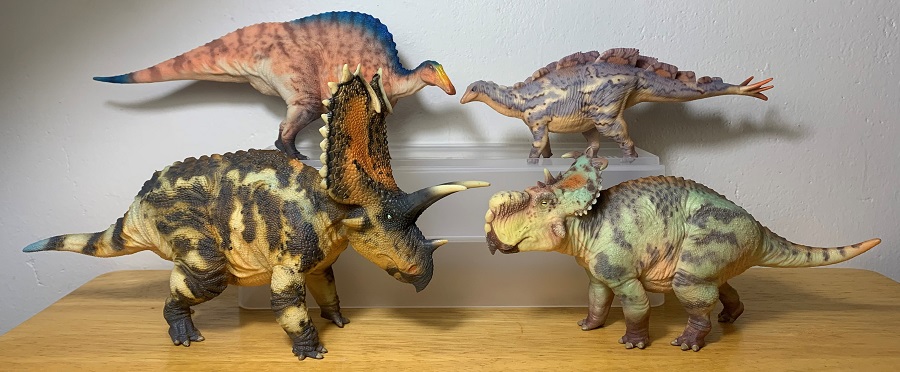
If I had to offer a criticism over the paintjob it would be that the figure is somewhat pale overall, giving it a hazy appearance and making finer details (like the nostrils) harder to notice. A dark wash over the figure would have helped bring out these fine details and I’ve seen some collectors do that to great effect. The colors themselves, the application, and the patterning, are all exquisite though.
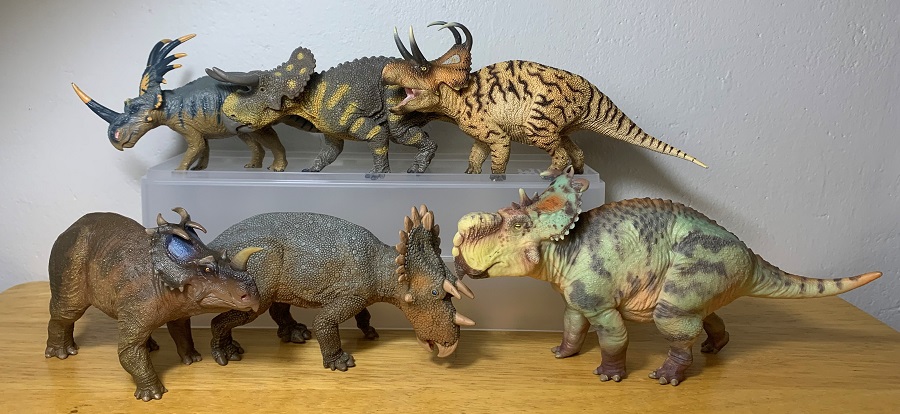
For me the Haolonggood Pachyrhinosaurus is the definitive version of this animal and I do not foresee myself ever acquiring another Pachyrhinosaurus for my collection unless it’s one of the other two species. It’s also sure to make my top ten of 2023 list, which will likely be dominated by Haolonggood figures this year. The Haolonggood Pachyrhinosaurus is widely available online for varying prices, but I got mine for about $17 through My Online Toy Store on Aliexpress. For that price this figure is an absolute steal. Through them you can also choose to forego the box which knocks off a couple dollars and the figure still comes nicely packed in the box’s foam insert. Additionally, Aliexpress offers various coupons that you can use to save some money too.
Support the Dinosaur Toy Blog by making dino-purchases through these links to Ebay and Amazon. Disclaimer: links to Ebay.com and Amazon.com on the Dinosaur Toy Blog are often affiliate links, when you make purchases through these links we may make a commission

I just got this one in the mail with 4 other Haolonggood figures (the first ones I’ve ever bought). I will order more of them tomorrow on “Black Friday”.
Words fail me.
Haolonggood has LAPPED PNSO, and I’ll tell you why:
a. Accuracy wise, they are almost up to PNSO. I’ll still give PNSO a SLIGHT advantage there on some sculpts; BUT – then Haolonggood hits a ‘GRAND SLAM HOMERUN” with:
b. THEIR. PAINT. JOBS. OMG – Words fail me. Out of this world doesn’t begin to describe the detail and beauty of their colors. And, at a MUCH lower price than PNSO’s offerings.
Haolonggood is now #1 with me. And one more thing – the colors on the figures look much BETTER in person than even in their stock photos. Like, when has that ever happened before?!?
Haolonggood continues to impress. I wasn’t expecting to be excited for another Pachyrhinosaurus either, but having it in hand has assuaged any indifference I had before. Thanks for the detailed review!
THIS. I will be getting this one for sure. It is the first Pachyr. figure that I am satisfied with. (I do have the Battat, which is OK, except for the plain paint job). I sold off the PNSO as I really disliked the pose, and the other ones out there are not worthy of mention.
This one just … looks …. RIGHT. Thick enough, pretty enough, rough enough (oops … started quoting a Rolling Stones song there ;>)
Anyhow … beautiful pose, paint up, detailing of the scales, etc … about the only critique (other than it being the same species done by every other company – a shame really, as P. Canadiensis in particular is Triceratops-sized, and would have made a bolder choice for a figure – after all, one skull has been found that is nearly 8 feet long), is the bluntness of the “hooks” on the frill, but with a little putty and paint I can correct that safety feature of the toy.
5-Star Review, 5-Star figure!!!
Thank you! Do you not like the Safari figure?
No, I actually don’t. I always thought the torso of the Wild Safari Pachyr. was too shallow and the animal looked a bit emaciated. I like Doug Watson’s sculpts – up to a point. He makes toy models that are necessarily limited in terms of level of detail because of the price point that the Wild Safari niche is targeted at. You really can’t compare the WS models to something as detailed as PNSO or Haolonggood. Its the minor and major leagues (to use a US baseball metaphor). Its not a fair comparison,in other words.
Now take Dan LoRusso’s Battat Pachyr. – there is an example of a “happy median” between quality and price. The level of detail is a bit soft, the paint job is basically non-existent (the worst of any Battat figure), but the general shape and massiveness of the animal is there, and the pose is interesting, though a bit difficult to position for pleasing shelf viewing.
Sounds like your issues with the Safari figure are similar to my own.
Great review. I also wasn’t exactly hankering for a new Pachyrhinosaurus given the more than a dozen figures that already exist, but this one really is top tier among them. There are a couple of aspects that I prefer on the Safari version, but Haolonggood’s is just so damned pretty.
Thank you! So…are you going to get it and replace the one you have now?
I bought the Haolonggood and I’ve been looking at them side by side, and I gotta say I’m leaning Safari!
Interesting. Care to explain? I’ve got Simon up above who doesn’t like Safari’s at all and while I like Safari’s I much prefer Haolonggood’s. Curious to get your perspective.
Sometimes it just comes down to which traits stand out to you most. I can see why the overall bulk of Haolonggood’s make it more appealing, and the paint job is not even in the same ballpark. But I’m an anatomy professor, so I tend to zero in on discrete traits. For example, the metacarpals of ceratopsians form an arch, which supports a lot of weight without using a lot of mass, analogous to our foot arches. Safari’s shows that nicely, while Haolonggood’s is flat-footed. The outermost digits of the hand touching the ground is a little annoying but not a big deal by itself. The jugal horn isn’t really rendered as a horn on Haolonggood’s. The tail is short like that of a chasmosaurine, whereas Pachyrhinosaurus had a relatively long tail. And the skull was broad and flared; somehow the one on the Haolonggood figure looks rolled down at the edges, making it too narrow in dorsal or anterior view. Like I said, it’s very pretty, and if it were the only Pachy toy on the market, or one of only a few, I probably wouldn’t be so hard on it. But when you make a popular species you invite closer scrutiny.
Thank you for that thought provoking reply – I’m gonna go back and take a closer look at those things you mentioned on the two figures … and see if there is anything I can do to correct them on the Haolonggood with a little “hobby modeling” …. ;>)
Thank you for the reply Halichoeres. I knew you would have a good explanation. Those are things I didn’t even notice. I try to be thorough but there are things that inevitably escape my attention, and I’m my no means an expert. I do wonder about the jugal bone though, do we know for certain that there should be a horn there or that it was not covered in skin?
I have a little expertise on mammals and fishes, but I’m definitely no dinosaur expert either. The book where the description of P. lakustai appears says it has “a hornlet (epijugal) on the tip of each cheek bone (jugal),” but it’s certainly possible that that’s been reappraised in the 15 years since.
Well your source, combined with virtually every other life reconstruction, is enough for me to think it must have had a little jugal horn. I will go back into the review and edit that in there. I’m surprised that I have not seen anyone else bring it up. In ceratopsians in general I’ve seen that a jugal horn is sometimes included and sometimes not so I was not sure if it was just artistic license of if we knew they were there for certain. In this case at least it appears that it should be there. Thanks again!
a beautiful figure. I agree that a P. canadensis is long overdue. Given that it was much larger than the other Pachyrhinosaurus species, you’d think that alone would have spawned a model or two of it by now.
Wonderful model (and review of it). I am becoming a big Haolonggood fan!
Thank you! Yes, I’m a fan for sure now. They’ve given me nothing to complain about.
I agree with your comments about the bulkiness of this figure and the Battat versus the Safari – I think that there is an instinctive sense that an animal that employs its head as a ram needs to have the heft of sheer mass to back it up.